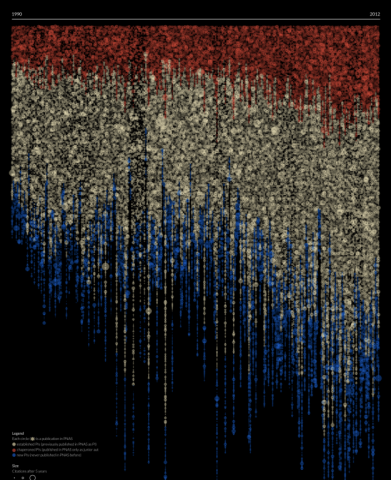Print Visualizations at Data Stories 2025
The Chaperone Effect in Scientific Publishing

Author:
Vedran Sekara
We use publication data provided by the Web of Science database to understand what role experience plays a in crafting high-impact scientific work. We ask the question: How likely is it for a scientist to appear as senior author in a journal if he or she has not previously published in the journal before? Here, we develop a quantitative understanding of author order by quantifying this “chaperone effect,” capturing how scientists transition into senior status within a particular publication venue. We illustrate that the chaperone effect has a different magnitude for journals in different branches of science, being more pronounced in medical and biological sciences and weaker in natural sciences.]\r\n\r\nThis visualization shows what role experience plays in getting published in PNAS. Each circle is a scientific paper published in PNAS from 1990 to 2012. The size of a circle is the papers "impact", measured by the cumulative number of citations a paper has received 5 years after publication. papers are colored according to the seniority status of their last author: new authors that have never published in PNAS before, chaperoned authors that have published in PNAS before only at junior level, and established authors that have already previously published as PIs in PNAS. The visualization reveals that a majority of papers published in PNAS come from established PIs, and these papers have, on average, higher impact relative to papers authored by new PIs.